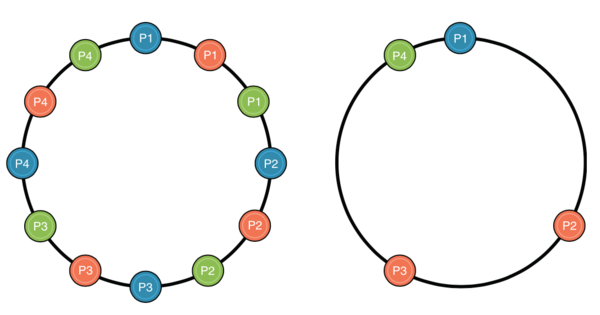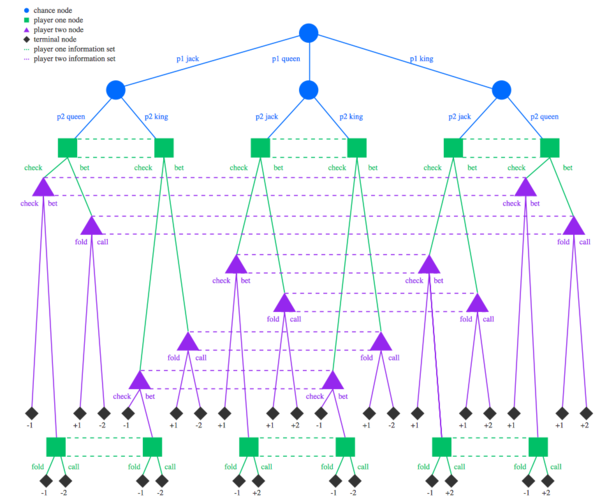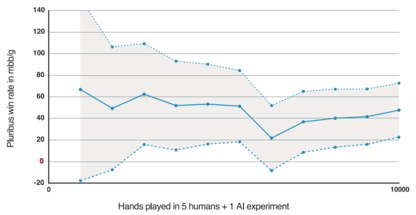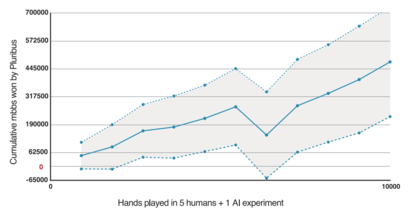Superhuman AI for Multiplayer Poker: Difference between revisions
| Line 38: | Line 38: | ||
At the start of each iteration, MCCFR stimulates a hand of poker randomly (Cards held by player at a given time) and designates one player as the traverser of the game tree. Once that is completed, the AI reviews the decision made by the traverser at a decision point in the game and investigates whether the decision was profitable. It compares it with other actions available to the traverser at that point and also with the future hypothetical decisions that would have been made following the other available actions. To evaluate a decision, Counterfactual Regret factor is used. This is the difference between what the traverser would have expected to receive for choosing an action and actually received on the iteration. Thus regret is a numeric value, where a positive regret indicates you regret your decision, a negative regret indicates you are happy with decision and zero regret indicates that you are indifferent. | At the start of each iteration, MCCFR stimulates a hand of poker randomly (Cards held by player at a given time) and designates one player as the traverser of the game tree. Once that is completed, the AI reviews the decision made by the traverser at a decision point in the game and investigates whether the decision was profitable. It compares it with other actions available to the traverser at that point and also with the future hypothetical decisions that would have been made following the other available actions. To evaluate a decision, Counterfactual Regret factor is used. This is the difference between what the traverser would have expected to receive for choosing an action and actually received on the iteration. Thus regret is a numeric value, where a positive regret indicates you regret your decision, a negative regret indicates you are happy with decision and zero regret indicates that you are indifferent. | ||
The value of counter factual regret for a decision is adjusted over the iterations as more scenarios or decision points are encountered. This means at the end of each iteration, the traverser’s strategy is updated so actions with higher counterfactual regret is chosen with higher probability. CFR minimizes regret over many iterations until the average strategy over all iterations converges and the average strategy is the approximated Nash equilibrium. CFR guarantees in all finite games that all counterfactual regrets grow sublinearly in the number of iterations. Pluribus uses Linear CFR in early iterations to reduce the influence of initial bad iterations i.e it assigns a weight of T to regret contributions at iteration T. | The value of counter factual regret for a decision is adjusted over the iterations as more scenarios or decision points are encountered. This means at the end of each iteration, the traverser’s strategy is updated so actions with higher counterfactual regret is chosen with higher probability. CFR minimizes regret over many iterations until the average strategy over all iterations converges and the average strategy is the approximated Nash equilibrium. CFR guarantees in all finite games that all counterfactual regrets grow sublinearly in the number of iterations. Pluribus uses Linear CFR in early iterations to reduce the influence of initial bad iterations i.e it assigns a weight of T to regret contributions at iteration T. This leads to the strategy improving more quickly in practice. | ||
An additional feature of Pluribus is that in the subgames, instead of assuming that all players play according to a single strategy, pluribus considers that each player may choose between k different strategies specialized to each player, when a decision point is reached. This results in the searcher choosing a more balanced strategy. For instance if a player never bluffs while holding the best possible hand then the opponents would learn that fact and always fold in that scenario. To fold in that scenario is a balanced strategy than to bet. | An additional feature of Pluribus is that in the subgames, instead of assuming that all players play according to a single strategy, pluribus considers that each player may choose between k different strategies specialized to each player, when a decision point is reached. This results in the searcher choosing a more balanced strategy. For instance if a player never bluffs while holding the best possible hand then the opponents would learn that fact and always fold in that scenario. To fold in that scenario is a balanced strategy than to bet. | ||
Revision as of 16:18, 22 November 2020
Presented by
Hansa Halim, Sanjana Rajendra Naik, Samka Marfua, Shawrupa Proshasty
Introduction
In the past two decades, most of the superhuman AI that were built can only beat human players in two-player zero-sum games. The most common strategy that the AI use to beat those games is to find the most optimal Nash equilibrium. A Nash equilibrium is the best possible choice that a player can take, regardless of what their opponent is going to choose.
More specifically, in the game of poker we only have AI models that can beat human players in two-player settings. Poker is a great challenge in AI and game theory because it captures the challenges in hidden information so elegantly. This means that developing a superhuman AI in multiplayer poker is the remaining great milestone in this field, because there is no polynomial-time algorithm that can find a Nash equilibrium in two-player non-zero-sum games, and having one would have surprising implications in computational complexity theory.
In this paper, the AI whom we call Pluribus, is capable of defeating human professional poker players in Texas hold'em poker which is a six-player poker game and is the most commonly played format in the world. The algorithm that is used are not guaranteed to converge to a Nash algorithm outside of two-player zero-sum games. However, it uses a strong strategy that is capable of consistently defeating elite human professionals. Which shows that despite not having strong theoretical guarantees on performance, they are capable of applying a wider class of superhuman strategies.
Nash Equilibrium in Multiplayer Games
Many AI have reached superhuman performance in games like checkers, chess, two-player limit poker, Go, and two-player no-limit poker. Nash equilibrium has been proven to always exists in all finite games, and the challenge is to find the equilibrium. It is the best possible strategy and is unbeatable in two-player zero-sum games, since it guarantees to not lose in expectation regardless what the opponent is doing.
The insufficiency with current AI systems is that they only try to achieve Nash equilibriums instead of trying to actively detect and exploit weaknesses in opponents. For example, let's consider the game of Rock-Paper-Scissors, the Nash equilibrium is to randomly pick any option with equal probability. However, we can see that this means the best strategy that the opponent can have will result in a tie. Therefore, in this example our player cannot win in expectation. Now let's try to combine the Nash equilibrium strategy and opponent exploitation. We can initially use the Nash equilibrium strategy and then change our strategy over time to exploit the observed weaknesses of our opponent. For example, we switch to always play Rock against our opponent who always plays Scissors. However, by shifting away from the Nash equilibrium strategy, it opens up the possibility for our opponent to use our strategy against ourselves. For example, they notice we always play Rock and thus they will now always play Paper.
Trying to approximate a Nash equilibrium is hard in theory, and in games with more than two players, it can only find a handful of possible strategies per player. Currently existing techniques to find ways to exploit an opponent require way too many samples and is not competitive enough outside of small games. Finding a Nash equilibrium in three or more players is a problem itself. If we can efficiently compute a Nash equilibrium in games more than two players, it is highly questionable if playing the Nash equilibrium strategy is a good choice. Additionally, if each player tries to find their own version of a Nash equilibrium, we could have infinitely many strategies and each player’s version of the equilibrium might not even be a Nash equilibrium.
Consider the Lemonade Stand example from Figure 1 Below. We have 4 players and the goal for each player is to find a spot in the ring that is furthest away from every other player. This way, each lemonade stand can cover as much selling region as possible and generate maximum revenue. In the left circle, we have three different Nash equilibria distinguished by different colours which would benefit everyone. The right circle is an illustration of what would happen if each player decides to calculate their own Nash equilibrium.

From the right circle in Figure 1, we can see that when each player tries to calculate their own Nash equilibrium, their own version of the equilibrium might not be a Nash equilibrium and thus they are not choosing the best possible location. This shows that attempting to find a Nash equilibrium is not the best strategy outside of two-player zero-sum games, and our goal should not be focused on finding a specific game-theoretic solution. Instead, we need to focus on observations and empirical results that consistently defeat human opponents.
Theoretical Analysis
Pluribus uses forms of abstraction to make computations scalable. To simplify the complexity due to too many decision points, some actions are eliminated from consideration and similar decision points are grouped together and treated as identical. This process is called abstraction. Pluribus uses two kinds of this abstraction: Action abstraction and information abstraction. Action abstraction reduces the number of different actions the AI needs to consider. For instance, it does not consider all bet sizes (exact number of bets it considers varies between 1 and 14 depending on the situation). Information abstraction groups together decision points that reveal similar information. For instance, the player’s cards and revealed board cards. This is only used to reason about situations on future betting rounds, never the current betting round.
Pluribus uses a builtin strategy - “Blueprint strategy”, which it gradually improves by searching in real time in situations it finds itself in during the course of the game. In the first betting round pluribus uses the initial blueprint strategy when the number of decision points is small. The blueprint strategy is computed using Monte Carlo Counterfactual Regret Minimization (MCCFR) algorithm. CFR is commonly used in imperfect information games AI which is trained by repeatedly playing against copies of itself, without any data of human or prior AI play used as input. For ease of computation of CFR in this context, poker is represented as a game tree. A game tree is a tree structure where each node represents either a player’s decision, a chance event, or a terminal outcome and edges represent actions taken.

At the start of each iteration, MCCFR stimulates a hand of poker randomly (Cards held by player at a given time) and designates one player as the traverser of the game tree. Once that is completed, the AI reviews the decision made by the traverser at a decision point in the game and investigates whether the decision was profitable. It compares it with other actions available to the traverser at that point and also with the future hypothetical decisions that would have been made following the other available actions. To evaluate a decision, Counterfactual Regret factor is used. This is the difference between what the traverser would have expected to receive for choosing an action and actually received on the iteration. Thus regret is a numeric value, where a positive regret indicates you regret your decision, a negative regret indicates you are happy with decision and zero regret indicates that you are indifferent.
The value of counter factual regret for a decision is adjusted over the iterations as more scenarios or decision points are encountered. This means at the end of each iteration, the traverser’s strategy is updated so actions with higher counterfactual regret is chosen with higher probability. CFR minimizes regret over many iterations until the average strategy over all iterations converges and the average strategy is the approximated Nash equilibrium. CFR guarantees in all finite games that all counterfactual regrets grow sublinearly in the number of iterations. Pluribus uses Linear CFR in early iterations to reduce the influence of initial bad iterations i.e it assigns a weight of T to regret contributions at iteration T. This leads to the strategy improving more quickly in practice.
An additional feature of Pluribus is that in the subgames, instead of assuming that all players play according to a single strategy, pluribus considers that each player may choose between k different strategies specialized to each player, when a decision point is reached. This results in the searcher choosing a more balanced strategy. For instance if a player never bluffs while holding the best possible hand then the opponents would learn that fact and always fold in that scenario. To fold in that scenario is a balanced strategy than to bet. Therefore, the blueprint strategy is produced offline for the entire game and it is gradually improved while making real time decisions during the game.
Experimental Results
To test how well Pluribus functions, it was tested against human players in 2 formats. The first format included 5 human players and one copy of Pluribus (5H+1AI). The 13 human participants were poker players who have won more than $1M playing professionally and were provided with cash incentives to play their best. 10,000 hands of poker were played over 12 days with the 5H+1AI format by anonymizing the players by providing each of them with aliases that remained consistent throughout all their games. The aliases helped the players keep track of the tendencies and types of games played by each player over the 10,000 hands played.
The second format included one human player and 5 copies of Pluribus (1H+5AI) . There were 2 more professional players who split another 10,000 hands of poker by playing 5000 hands each and followed the same aliasing process as the first format. Performance was measured using milli big blinds per game, mbb/game, (i.e. the initial amount of money the second player has to put in the pot) which is the standard measure in the AI field. Additionally, AIVAT was used as the variance reduction technique to control for luck in the games, and significance tests were run at a 95% significance level with one-tailed t-tests as a check for Pluribus’s performance in being profitable.
Applying AIVAT the following were the results:
| Format | Average mbb/game | Standard Error in mbb/game | P-value of being profitable |
|---|---|---|---|
| 5H+1AI | 48 | 25 | 0.028 |
| 1H+5AI | 32 | 15 | 0.014 |


As Pluribus’s strategy was not developed with any human data and was trained by self-play only, it is an unbiased and different perspective on how optimal play can be attained. A standard convention of “limping” in poker (calling the 'big blind' rather than folding or raising) is confirmed to be not optimal by Pluribus since it initially experimented with it but eliminated this from its strategy over its games of self-play. On the other hand, another convention of “donk betting” (starting a round by betting when someone else ended the previous round with a call) that is dismissed by players was adopted by Pluribus much more often than played by humans, and is proven to be profitable.
Discussion and Critiques
The blueprint strategy for Pluribus uses two abstraction methods which reduces the computational power required. Thus Pluribus was computed in 8 days and required less than 512 GB of memory, and costs about $144 to produce. This is in sharp contrast to all the other recent superhuman AI milestones for games. This is a great way the researchers have condensed down the problem to fit the current computational powers.
Pluribus definitely shows that we can capture observational data and empirical results to construct a superhuman AI without requiring theoretical guarantees, this can be a baseline for future AI inventions and help in the research of AI. It would be interesting to use Pluribus's way of using non-theoretical approach in more real life problems such as autonomous driving or stock market trading.
Conclusion
As Pluribus’s strategy was not developed with any human data and was trained by self-play only, it is an unbiased and different perspective on how optimal play can be attained. Developing a superhuman AI for multiplayer poker was a widely recognized milestone in this area and the major remaining milestone in computer poker. Pluribus’s success shows that despite the lack of known strong theoretical guarantees on performance in multiplayer games, there are large-scale, complex multiplayer imperfect information settings in which a carefully constructed self-play-with-search algorithm can produce superhuman strategies.
References
Noam Brown and Tuomas Sandholm (July 11, 2019). Superhuman AI for multiplayer poker. Science 365.
Osborne, Martin J.; Rubinstein, Ariel (12 Jul 1994). A Course in Game Theory. Cambridge, MA: MIT. p. 14.
Justin Sermeno. (2020, November 17). Vanilla Counterfactual Regret Minimization for Engineers. https://justinsermeno.com/posts/cfr/#:~:text=Counterfactual%20regret%20minimization%20%28CFR%29%20is%20an%20algorithm%20that,decision.%20It%20can%20be%20positive%2C%20negative%2C%20or%20zero